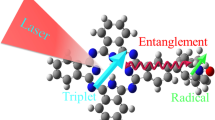Abstract
The importance of photochemical reactions proceeding through the formation of spin-correlated radical pairs is becoming increasingly apparent, due to their roles in biological magnetic field sensing and optoelectronic devices. Here, we consider the spin-dynamics of triplet born radical pairs under varying weak magnetic field conditions and in doing so provide a simplified model for understanding the low field effect by identifying triplet states that cannot undergo coherent mixing to singlet states in zero magnetic field.


Similar content being viewed by others
Code Availability
The code used for the simulations described in this work is available from the corresponding author on reasonable request.
References
G. Closs, J. Am. Chem. Soc. 91(16), 4552–4554 (1969)
R. Kaptein, J. Oosterhoff, Chem. Phys. Letts. 4, 195 (1969)
R. Kaptein, J. Oosterhoff, Chem. Phys. Lett. 4, 214–216 (1969)
R.W. Fessenden, R.H. Schuler, J. Chem. Phys. 39(9), 2147–2195 (1963)
J. Bargon, H.F., Johnsen, U. Naturforsch. 22, 1551–1555 (1967)
J. Bargon, H.F., Johnsen, U. Naturforsch. 22, 1556–1560 (1967)
H.R. Ward, R.G. Lawler, J. Am. Chem. Soc. 89, 5518–5519 (1967)
R. Sagdeev, Y. Molin, K. Salikhov, T. Leshina, M. Kamha, S. Shein, Org. Magn. Reson. Soc. 5, 603–605 (1973)
B. Brocklehurst, R.S. Dixon, E. Gardy, V. Lopata, M. Quinn, A. Singh, F. Sargent, Chem. Phys. Lett. 28, 361–363 (1974)
K. Maeda, K.B. Henbest, F. Cintolesi, I. Kuprov, D.T. Rodgers, P.A. Liddell, D. Gust, C.R. Timmel, P.J. Hore, Nature 453, 387–390 (2008)
P.W. Atkins, G.T. Evans, Chem. Phys. Lett. 25(1), 108–110 (1974)
B. Brocklehurst, K.A. McLauchlan, Int. J. Radiat. Biol. 69(1), 3–24 (1995)
A.M. Lewis, T.P. Fay, D.E. Manolopoulos, C. Kerpal, S. Richert, C.R. Timmel, J. Chem. Phys. 149, 034103 (2018)
R. Haberkorn, Mol. Phys. 32(5), 1491–1493 (1976)
H.J. Hogben, M. Krzystyniak, G.T.P. Charnock, P.J. Hore, I.J. Kuprov, Mag. Reson. 208, 179–194 (2012)
C.R. Timmel, P.J. Hore, Chem. Phys. Lett. 257, 40–408 (1996)
Funding
This work was supported by the Japan Society for the Promotion of Science (JSPS) Grants-in-Aid for Scientific Research (Grant number 20H02687).
Author information
Authors and Affiliations
Contributions
J. R. Woodward did all research and wrote the manuscript.
Corresponding author
Ethics declarations
Conflict of Interest
The authors declare no competing interests.
Additional information
Publisher's Note
Springer Nature remains neutral with regard to jurisdictional claims in published maps and institutional affiliations.
Rights and permissions
Springer Nature or its licensor holds exclusive rights to this article under a publishing agreement with the author(s) or other rightsholder(s); author self-archiving of the accepted manuscript version of this article is solely governed by the terms of such publishing agreement and applicable law.
About this article
Cite this article
Woodward, J.R. Triplet Born Radical Pairs and the Low Field Effect. Appl Magn Reson 54, 47–58 (2023). https://doi.org/10.1007/s00723-022-01485-9
Received:
Revised:
Accepted:
Published:
Issue Date:
DOI: https://doi.org/10.1007/s00723-022-01485-9




